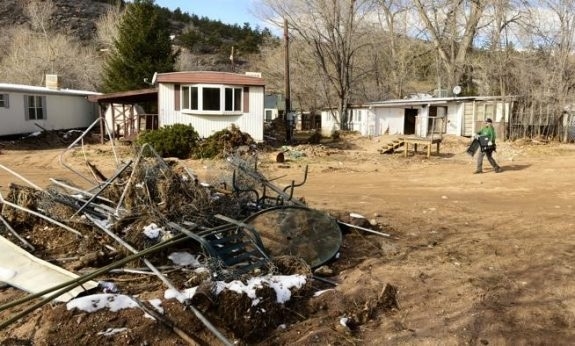
According to former resident Sandy Sharpe who lived at the River Bend Mobile Home Park, “Many of us were uprooted and forced to move because we no longer had a place to live, and there were not any homes we could occupy in Lyons.” She explained that “We had no choice but to begin new lives without waiting or wanting to see if the town would provide housing, perhaps to the relief of some concerned about property values. Most of us had to commit to other conditions we didn’t want, based on our financial means at a disastrous time.”
She said that now, many of those desiring to return simply can’t do that on their own. She explained that most people committed what finances they had left at the time to whatever housing they were able to find. “We were forced to move on. Most of us are still waiting for an opportunity to return,” she added.
The effects of the floods in 2013 were devastating to several towns along the St. Vrain River. The Denver Post tells MHProNews that the state of Colorado knew of 154 flood-destroyed manufactured homes and another 901 that were damaged in 11 communities located in the flood zone, according to Kerri Nelson, Colorado’s deputy chief recovery officer. Authorities were reluctant to allow residents of some of the areas hardest hit to return and repair any home that might be salvageable. Nor would they allow new homes to be built or located there because of the fear of additional flooding.
Entire neighborhoods in Evans, Longmont, Lyons and Milliken were gone for good, as planners felt there were better uses for the land and safer places to resettle. A large portion of lower-cost housing stock was lost in the northern Colorado area. Today, approximately 18 months after the flood, most of the people who lost their manufactured homes are living elsewhere because there was nowhere for them to live in their previous communities.
“I now understand the word catastrophe,” Lyons Mayor Julie Van Domelen said. “The destruction along the river was jaw-dropping.” As a result she said the town lost 20 percent of its housing stock. She said, “It’s not easy to replace lost housing. Finding land for residential development is a big challenge because we have no space for it.”
After researching the situation for months, the City of Lyons is going to hold a vote in March for qualified voters to determine whether the city will use several acres of the 40-acre Bohn Park to build replacement housing for flood victims. This town that sits in the foothills of the Front Range cannot find other land on which to build new housing.
Unfortunately, former residents who no longer live in Lyons will not be able to vote. Former resident Sharpe said that those who have had to live in other towns feel left out of this process. “We have been denied any voice in a possible future for us in Lyons,” she said. “Unfortunately, those of us most directly affected by this vote are not allowed to participate. We are no longer residents, but many of us want to be. So, we have to depend on others to speak for us.”
Other passionate pleas came from residents who implored the board to bring the 100 displaced families home quickly. “I am the face of the people who can’t afford to live here anymore if we don’t do this,” said Jenna Brink, who lost her manufactured home in the flood. “There is nowhere else to go. Something needs to be done so that we can come home.”
It is unknown whether manufactured homes will be allowed in the new development, if the measure passes. ##
(Photo Credit: The Denver Post)
Article submitted by Sandra Lane to – Daily Business News – MHProNews.


























